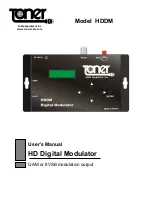
Remote Control Functions
16
“
Ǻ
button
Call up the Timer menu by pressing the
“
Ǻ
button.
Exit the Timer menu by pressing the
“
Ǻ
button again.
O
button
The programme position number is displayed for approx.
3 seconds in the TV mode if you press the
O
button.
In addition, this button is required for a variety of other func-
tions.
Battery display
If the battery voltage of the battery in the infrared remote con-
trol falls below a certain level, "
b
AA
tt
" appears in the display for
approx. 5 seconds
every time you carry out a remote control
command
.
Switching remote control
In order to control and operate two independent SAT receivers
simultaneously, you can switch the remote control between
the two receivers. When you switch the receiver on
with the
P/F button depressed
, the current level "
II
r
II
" appears for
approx. 3 seconds.
If you keep the P/F button depressed, the receiver switches to
the second level, "
II
r
22
" .
The remote control is converted by means of a soldered
connection. Your dealer will be glad to help if you have any
inquiries.
Datalink
– Data transfer
Two complete memory data records can be transferred from
a transmitting receiver to a receiving receiver via the VCR
socket
´Z
.
Connect both units with a cinch cable.
Switch the receiving unit on.
Switch the transmitting unit on with the
ɦ
button held down.
It then transfers the programme data to the receiving unit.
"
SEnd
" (sending data) appears in the LED display. When the
data are recognized by the receiving unit, the LED display of
the receiving unit switches from the programme number to
"
rEC
" (receiving data).
The transmission lasts approx. 50 seconds. As soon as it is
successfully completed, "
P1
" appears in both displays for
programm number 1.
If an error occures during transmission, "
Err
" appears in the
display of the receiving unit.
Datalink is only possible with units which, like your unit,
allow LNC frequency selection.
Direct programme selection
You can directly select programmes by pressing the corre-
sponding buttons
“
1
...
“
9
.
Pressing the respective button 1... 9 causes the programme
position number (for example,
P1..
) to appear on the screen
for approx. 3 seconds. Within this time, you can enter the
number of a programme with the buttons 0 ... 9.
If you do not make any inputs, the programme position num-
ber jumps to the one-position. After a brief interval, the num-
ber disappears from the screen.
199 programme positions are available for the TV, and 99 for
the radio.
Switching between radio/TV
Use the
“
0
button to switch between the radio and the TV.
The most previously selected programme position is automa-
tically selected. In radio mode, the screen is dark and "RADIO"
appears with the programme position number in the upper
part of the screen. An LED on the receiver indicates radio ope-
ration (see the chapter on selecting radio operation).
Programme buttons
“
ǵ
“
Ƕ
You advance from programme position to programme positi-
on with the
“
ǵ
“
Ƕ
buttons. Keeping the buttons depressed
scrolls through the programme positions.
Stand by
“
Ǽ
The
“
Ǽ
button switches the receiver to stand by. The display
shows "–". LNC, switching and AV voltages are switched off.
You can switch the receiver on again with the numeric buttons
“
1
“
9
. The
“
ǵ
“
Ƕ
buttons are used to switch the recei-
ver to the programme most previously tuned to (Last Station
Memory).
“
TV
button
Appropriaely equipped television sets can be switched to
terrestrial programme positions with the
“
TV button.





































